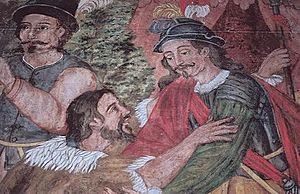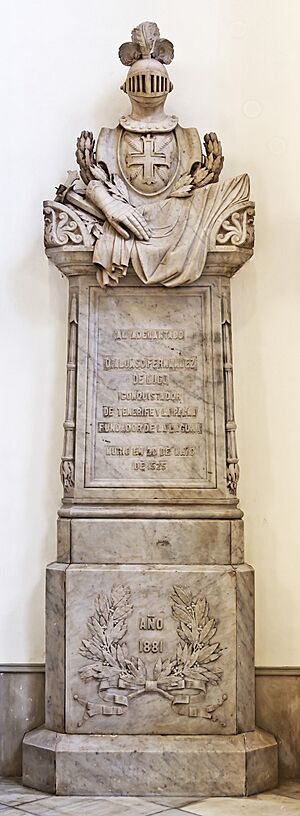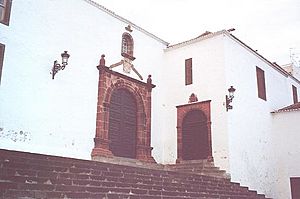Alonso Fernández de Lugo facts for kids
Quick facts for kids
Alonso Fernández de Lugo
|
|
|---|---|

The native kings of Tenerife surrender to Alonso Fernández de Lugo, 25 July 1496.
|
|
| Born | uncertain |
| Died | 1525 |
| Occupation | Military governor for the Crown of Castile |
Alonso Fernández de Lugo (died 1525) was a Spanish military leader and explorer. He was known as a conquistador, which means he helped conquer new lands for the Castilian Crown. He also founded several important towns.
Fernández de Lugo conquered the islands of La Palma (1492–1493) and Tenerife (1494–1496). These were the last of the Canary Islands to be taken over by Europeans. He also founded the towns of San Cristóbal de La Laguna, Santa Cruz de Tenerife, and Santa Cruz de La Palma. He was known for being a strong leader who could bring order to new lands.
Contents
Early Life and Military Career
Fernández de Lugo was born in Sanlúcar de Barrameda, Spain. His family came from Galicia. We don't know much about his early life.
He joined the navy and became an important leader. He reached the rank of Adelantado, which was a special title given to military governors. He was also a Captain General for the coasts of Africa.
In 1478, he helped conquer Gran Canaria. He later commanded the castle of Agaete on Gran Canaria.
Conquering La Palma
Fernández de Lugo went back to Spain to ask for money from the King and Queen. He wanted to conquer Tenerife and La Palma. He was made governor of La Palma. He was given money to conquer the island within a year.
The conquest of La Palma started on September 29, 1492. Fernández de Lugo landed on the beaches of Tazacorte. He faced strong resistance from some of the native Guanches chiefs.
However, most of the Guanche kings, called menceys, on La Palma surrendered by April 1493. Only Tanausu, who ruled the area of Acero (Caldera de Taburiente), continued to fight.
Tanausu was captured in May 1493 after agreeing to a truce. This truce was arranged by Fernández de Lugo and Juan de Palma. Juan de Palma was a Guanche who had become a Christian and was related to Tanausu. The conquest of La Palma was finished on May 3, 1493. Fernández de Lugo left his nephew, Juan, in charge of La Palma. Then, he began to plan the conquest of Tenerife.
Conquering Tenerife
During the conquest of Tenerife, Fernández de Lugo suffered a big defeat. This happened at the First Battle of Acentejo on May 31, 1494. He was hurt but managed to escape by swapping his special red cape for a common soldier's cape. During this battle, a rock hit his head, and he lost most of his teeth.
By October, he had gathered a second, larger army. He received help from the Duke of Medina Sidonia and other nobles. After his defeat, Fernández de Lugo was more careful. He moved slowly across the island, building and rebuilding forts.
He had sold all his own property to pay for this expedition. He landed at Añazo and built two towers there. A powerful lady named Inés Peraza also helped him. She provided a lot of supplies for his campaign.
Fernández de Lugo now had more experienced soldiers. These included 1,000 foot soldiers who had fought in the conquest of Granada. The King and Queen, Ferdinand and Isabella, also supported him. They gave him ten more months to finish conquering the Canary Islands.
With this better plan, he won against the Guanches of Tenerife. He won the Battle of Aguere (November 14–15, 1494) and the Second Battle of Acentejo (December 25, 1494).
After the Conquest


After his victories, he was made governor and chief judge of both Tenerife and La Palma. He was also named Captain General of the African coast. He received the title of Adelantado on January 12, 1503. This title was later confirmed by Charles I of Spain in 1519. It was a title that could be passed down through his family.
Fernández de Lugo was given great power over these islands. This was because he had paid for their conquest himself. On La Palma, he controlled how land and water were given out. He chose to live on Tenerife but kept the rich area of Los Sauces on La Palma for himself.
He had a lot of power over the islands. He could make decisions about laws and appoint judges. He also controlled who could enter and leave the islands. He encouraged people to settle on the islands by limiting the sale of land.
Many people moved to Tenerife and La Palma between the late 1490s and the 1520s. These immigrants came from different parts of Europe. They included people from Castile, Portugal, Italy, Catalonia, Basques, and Flanders.
On Tenerife, he founded the town of San Cristóbal de La Laguna. The Plaza del Adelantado and Calle Adelantado in this town are named after him. A local story says that when one of his sons died in the town, Fernández de Lugo ordered the street of La Carrera to be made twisted. This was so he would not have to see the place where his son died from his home.
On La Palma, he founded the town of Santa Cruz de La Palma on May 3, 1493. It was first called Villa del Apurión.
On July 21, 1509, he passed on his titles and rights for the African coast to his son, Pedro Fernández de Lugo. His son later took part in expeditions to the New World.
Alonso Fernández de Lugo is buried in the Cathedral of La Laguna. He even appeared on a 1961 postal stamp for the Spanish Sahara.
Images for kids
See also
 In Spanish: Alonso Fernández de Lugo para niños
In Spanish: Alonso Fernández de Lugo para niños






